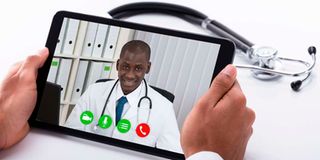Role of digital systems in managing cardiovascular diseases

E-health has been a powerful tool for cardiovascular disease secondary prevention.
I have been a consultant cardiologist since 2000, and since then, I have witnessed a drastic change in technology in the field.
Health technology has since been recognised worldwide, with the use of the internet and other Information and Communication Technologies being applied to provide innovative health service and deliver health information (commonly referred to as electronic or digital health). This has become the mainstream of mobile health (m-Health or e-Health) that has been employed by many individuals and institutions.
The World Health Organization defines mobile health as “The use of mobile and wireless technologies to support the achievement of a health objective”.
From the comfort of home
This might include text messaging, Bluetooth technologies in medical equipment, and sophisticated hemodynamic monitoring machines. With the rising incidence of self-isolation, curfews and travel restrictions, many people prefer being attended to from the comfort of their homes.
This trend began with simple medical procedures and conditions and is rapidly developing to cover more complex cases. For instance, we can now monitor a pacemaker through a phone line while the patient is at home. Sounds simple, right?
Diseases that affect the heart or blood vessels, also known as cardiovascular diseases, are still the leading cause of mortality and morbidity. The fear of going to hospital, which falsely and rapidly spread among people during the Covid-19 pandemic, has deprived many patients of medical emergency help, and has caused a rapid rise in cardiovascular mortality.
E-health has in this setting been a powerful tool for cardiovascular disease (CVD) secondary prevention. It has been used as a remote cardiac rehabilitation tool for patients after myocardial infarction.
eMedicine, otherwise known as Telemedicine, has also been used in educating and engaging people of age 60 and above because they are at the highest risk of CVD. At the moment, there are various apps available on mobile phones that give advice on management for both healthcare providers and patients with CVD.
Routine blood sugar analysis, for example, can now be done in seconds on your mobile phone by scanning your pulp on the back camera. This not only empowers the person affected to detect their conditions early enough but also allows for easier and better intervention by the cardiologist.
The management of patients with coronary heart disease can sometimes require difficult decision-making. This is why it traditionally required discussions in multi-disciplinary team meetings (MDT meetings) between cardiothoracic surgeons and cardiologists to decide if the patient is going for Coronary Artery Bypass Operation (CABG op) or just a stent (Angioplasty).
Such a decision can now be done digitally in five minutes by a mobile app (e.g. SYNTAX score). This may replace the MDT meeting as the app is now used by most cardiologists worldwide.
Damage in heart muscle
With the new echo equipment, we can acquire Echo pictures with a very high frame rate of more than 160 frames per seconds. This enables us to study the subtle contraction pattern and diagnose micro damage in the heart muscle. The M. P. Shah Hospital cardiology department strongly believes in new digital technology, and is motivated to incorporate it in our daily practice.
We now have one of the most modern echo equipment, with advanced digital logarithm, to diagnose cardiovascular disease.
Dr Mohsen Gaballa, MD, FESC, FSCAI, is Head of Cardiovascular Department at M.P. Shah Hospital.




